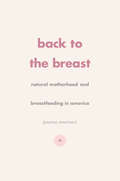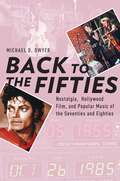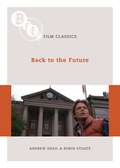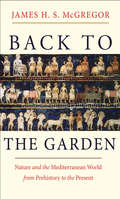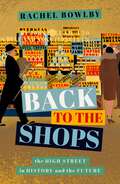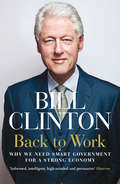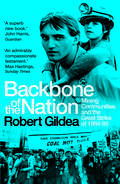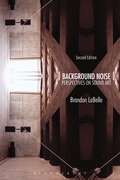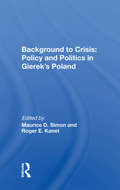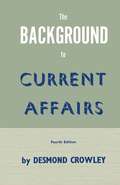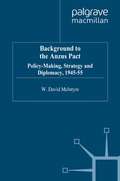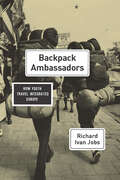- Table View
- List View
Back to the ‘30s?: Recurring Crises of Capitalism, Liberalism, and Democracy
by Susan Falls Jeremy Rayner George Souvlis Taylor C. NelmsThe essays in this volume address the question: what does it mean to understand the contemporary moment in light of the 1930s? In the aftermath of the worst economic crisis since the Great Depression, and facing a dramatic rise of right wing, authoritarian politics across the globe, the events of the 1930s have acquired a renewed relevance. Contributions from a diverse, interdisciplinary group of scholars address the relationship between these historical moments in various geographical contexts, from Asia-Pacific to Europe to the Americas, while probing an array of thematic questions—the meaning of populism and fascism, the contradictions of constitutional liberalism and “militant democracy,” long cycles and crisis tendencies in capitalism, the gendering and racialization of right wing movements, and the cultural and class politics of emancipatory struggles. Uncovering continuity as well as change and repetition in the midst of transition, Back to the 30s? enriches our ability to use the past to evaluate the challenges, dangers, and promises of the present.
Back to the Breast: Natural Motherhood and Breastfeeding in America
by Jessica MartucciAfter decades of decline during the twentieth century, breastfeeding rates began to rise again in the 1970s, a rebound that has continued to the present. While it would be easy to see this reemergence as simply part of the naturalism movement of the ’70s, Jessica Martucci reveals here that the true story is more complicated. Despite the widespread acceptance and even advocacy of formula feeding by many in the medical establishment throughout the 1940s, ’50s, and ’60s, a small but vocal minority of mothers, drawing upon emerging scientific and cultural ideas about maternal instinct, infant development, and connections between the body and mind, pushed back against both hospital policies and cultural norms by breastfeeding their children. As Martucci shows, their choices helped ideologically root a “back to the breast” movement within segments of the middle-class, college-educated population as early as the 1950s. That movement—in which the personal and political were inextricably linked—effectively challenged midcentury norms of sexuality, gender, and consumption, and articulated early environmental concerns about chemical and nuclear contamination of foods, bodies, and breast milk. In its groundbreaking chronicle of the breastfeeding movement, Back to the Breast provides a welcome and vital account of what it has meant, and what it means today, to breastfeed in modern America.
Back to the Breast: Natural Motherhood and Breastfeeding in America
by Jessica MartucciAfter decades of decline during the twentieth century, breastfeeding rates began to rise again in the 1970s, a rebound that has continued to the present. While it would be easy to see this reemergence as simply part of the naturalism movement of the ’70s, Jessica Martucci reveals here that the true story is more complicated. Despite the widespread acceptance and even advocacy of formula feeding by many in the medical establishment throughout the 1940s, ’50s, and ’60s, a small but vocal minority of mothers, drawing upon emerging scientific and cultural ideas about maternal instinct, infant development, and connections between the body and mind, pushed back against both hospital policies and cultural norms by breastfeeding their children. As Martucci shows, their choices helped ideologically root a “back to the breast” movement within segments of the middle-class, college-educated population as early as the 1950s. That movement—in which the personal and political were inextricably linked—effectively challenged midcentury norms of sexuality, gender, and consumption, and articulated early environmental concerns about chemical and nuclear contamination of foods, bodies, and breast milk. In its groundbreaking chronicle of the breastfeeding movement, Back to the Breast provides a welcome and vital account of what it has meant, and what it means today, to breastfeed in modern America.
Back to the Breast: Natural Motherhood and Breastfeeding in America
by Jessica MartucciAfter decades of decline during the twentieth century, breastfeeding rates began to rise again in the 1970s, a rebound that has continued to the present. While it would be easy to see this reemergence as simply part of the naturalism movement of the ’70s, Jessica Martucci reveals here that the true story is more complicated. Despite the widespread acceptance and even advocacy of formula feeding by many in the medical establishment throughout the 1940s, ’50s, and ’60s, a small but vocal minority of mothers, drawing upon emerging scientific and cultural ideas about maternal instinct, infant development, and connections between the body and mind, pushed back against both hospital policies and cultural norms by breastfeeding their children. As Martucci shows, their choices helped ideologically root a “back to the breast” movement within segments of the middle-class, college-educated population as early as the 1950s. That movement—in which the personal and political were inextricably linked—effectively challenged midcentury norms of sexuality, gender, and consumption, and articulated early environmental concerns about chemical and nuclear contamination of foods, bodies, and breast milk. In its groundbreaking chronicle of the breastfeeding movement, Back to the Breast provides a welcome and vital account of what it has meant, and what it means today, to breastfeed in modern America.
Back to the Breast: Natural Motherhood and Breastfeeding in America
by Jessica MartucciAfter decades of decline during the twentieth century, breastfeeding rates began to rise again in the 1970s, a rebound that has continued to the present. While it would be easy to see this reemergence as simply part of the naturalism movement of the ’70s, Jessica Martucci reveals here that the true story is more complicated. Despite the widespread acceptance and even advocacy of formula feeding by many in the medical establishment throughout the 1940s, ’50s, and ’60s, a small but vocal minority of mothers, drawing upon emerging scientific and cultural ideas about maternal instinct, infant development, and connections between the body and mind, pushed back against both hospital policies and cultural norms by breastfeeding their children. As Martucci shows, their choices helped ideologically root a “back to the breast” movement within segments of the middle-class, college-educated population as early as the 1950s. That movement—in which the personal and political were inextricably linked—effectively challenged midcentury norms of sexuality, gender, and consumption, and articulated early environmental concerns about chemical and nuclear contamination of foods, bodies, and breast milk. In its groundbreaking chronicle of the breastfeeding movement, Back to the Breast provides a welcome and vital account of what it has meant, and what it means today, to breastfeed in modern America.
Back to the Fifties: Nostalgia, Hollywood Film, and Popular Music of the Seventies and Eighties (Oxford Music / Media)
by Michael D. DwyerThroughout the 1970s and 1980s, Hollywood studios and record companies churned out films, albums, music videos and promotional materials that sought to recapture, revise, and re-imagine the 1950s. Breaking from dominant wisdom that casts the trend as wholly defined by Ronald Reagan's politics or the rise of postmodernism, Back to the Fifties reveals how Fifties nostalgia from 1973 to 1988 was utilized by a range of audiences for diverse and often competing agendas. Films from American Graffiti to Hairspray and popular music from Sha Na Na to Michael Jackson shaped - and were shaped by - the complex social, political and cultural conditions of the Reagan Era. By closely examining the ways that "the Fifties" was remade and recalled, Back to the Fifties explores how cultural memories were fostered for a generation of teenagers trained by popular culture to rewind, record, recycle and replay.
BACK TO THE FIFTIES OMMS C: Nostalgia, Hollywood Film, and Popular Music of the Seventies and Eighties (Oxford Music / Media)
by Michael D. DwyerThroughout the 1970s and 1980s, Hollywood studios and record companies churned out films, albums, music videos and promotional materials that sought to recapture, revise, and re-imagine the 1950s. Breaking from dominant wisdom that casts the trend as wholly defined by Ronald Reagan's politics or the rise of postmodernism, Back to the Fifties reveals how Fifties nostalgia from 1973 to 1988 was utilized by a range of audiences for diverse and often competing agendas. Films from American Graffiti to Hairspray and popular music from Sha Na Na to Michael Jackson shaped - and were shaped by - the complex social, political and cultural conditions of the Reagan Era. By closely examining the ways that "the Fifties" was remade and recalled, Back to the Fifties explores how cultural memories were fostered for a generation of teenagers trained by popular culture to rewind, record, recycle and replay.
Back to the Front: An Accidental Historian Walks the Trenches of World War 1
by Stephen O'SheaWorld War I is beyond the memory of almost everyone alive today. Yet it has left as deep a scar on the imaginative landscape of our century as it has on the land where it was fought. Nowhere is that more evident than on the Western Front-the sinuous, deadly line of trenches that stretched from the coast of Belgium to the border of France and Switzerland, a narrow swath of land in which so many million lives were lost.For journalist Stephen O'Shea, the legacy of the Great War is personal (both his grandfathers fought on the front lines) and cultural. Stunned by viewing the "immense wound" still visible on the battlefield of the Somme, and feeling that "history is too important to be left to the professionals," he set out to walk the entire 450 miles through no-man's-land to discover for himself and for his generation the meaning of the war.Back to the Front is a remarkable combination of vivid history and opinionated travel writing. As his walk progresses, O'Shea recreates the shocking battles of the Western Front, many now legendary-Passchendaele, the Somme, the Argonne, Verdun-and offers an impassioned perspective on the war, the state of the land, and the cultivation of memory. His consummate skill with words and details brings alive the players, famous and faceless, on that horrific stage, and makes us aware of why the Great War, indeed history itself, still matters. An evocative fusion of past and present, Back to the Front will resonate, for all who read it, as few other books on war ever have.
Back to the Future (BFI Film Classics)
by Robin Stoate Andrew ShailThis compelling study places 'Back to the Future' in the context of Reaganite America, discusses Robert Zemeckis's film-making technique and its relationship to the 'New New Hollywood', explores the film's attitudes to teen culture of the 1950s and 1980s and its representation of science, atomic power and time travel.
Back to the Future (BFI Film Classics)
by Robin Stoate Andrew ShailThis compelling study places 'Back to the Future' in the context of Reaganite America, discusses Robert Zemeckis's film-making technique and its relationship to the 'New New Hollywood', explores the film's attitudes to teen culture of the 1950s and 1980s and its representation of science, atomic power and time travel.
Back to the Garden: Nature and the Mediterranean World from Prehistory to the Present
by James H. McGregorThe garden was the cultural foundation of the early Mediterranean peoples; they acknowledged their reliance on and kinship to the land, and they understood nature through the lens of their diversely cultivated landscape. Their image of the garden underwrote the biblical book of Genesis and the region’s three major religions. In this important melding of cultural and ecological histories, James H. S. McGregor suggests that the environmental crisis the world faces today is a result of Western society’s abandonment of the “First Nature” principle--of the harmonious interrelationship of human communities and the natural world. The author demonstrates how this relationship, which persisted for millennia, effectively came to an end in the late eighteenth century, when “nature” came to be equated with untamed landscape devoid of human intervention. McGregor’s essential work offers a new understanding of environmental accountability while proposing that recovering the original vision of ourselves, not as antagonists of nature but as cultivators of a biological world to which we innately belong, is possible through proven techniques of the past.
Back to the Shops: The High Street in History and the Future
by Rachel BowlbyWhat will become of the shops? More than ever, the high street appears to be under mortal threat, its shops boarded up as the sad 'bricks and mortar' survivals of a pre-online retail world. But behind the bleak appearance, there is more to see. Back to the Shops offers a set of short and surprising chapters, each one a window into a different shop type or mode of selling. Old shopping streets are seen from new angles; fast fashion shows up in eighteenth-century edits. Here are pedlars and pop-ups, mail order catalogues and mobile greengrocers' shops. Here too are food markets open till late on a Saturday night, and tiny subscription libraries tucked away at the back of the sweet shop. Over time, shops have occupied radically different places in cultural arguments and in our everyday lives. They are essential sources of daily provisions, but they are also the visible evidence of consuming excess. They are local community hubs and they are dreamlands of distraction. Shops are inherently spaces of imagination as well as of practicality. They belong with their own surrounding streets and town; they bring back the times and places of our lives. They linger in stories of all kinds, whether far-fetched or round the corner. From butcher to baker and from markets to motor vans—after reading this book, you will want to go back to the shops.
Back to the Shops: The High Street in History and the Future
by Rachel BowlbyWhat will become of the shops? More than ever, the high street appears to be under mortal threat, its shops boarded up as the sad 'bricks and mortar' survivals of a pre-online retail world. But behind the bleak appearance, there is more to see. Back to the Shops offers a set of short and surprising chapters, each one a window into a different shop type or mode of selling. Old shopping streets are seen from new angles; fast fashion shows up in eighteenth-century edits. Here are pedlars and pop-ups, mail order catalogues and mobile greengrocers' shops. Here too are food markets open till late on a Saturday night, and tiny subscription libraries tucked away at the back of the sweet shop. Over time, shops have occupied radically different places in cultural arguments and in our everyday lives. They are essential sources of daily provisions, but they are also the visible evidence of consuming excess. They are local community hubs and they are dreamlands of distraction. Shops are inherently spaces of imagination as well as of practicality. They belong with their own surrounding streets and town; they bring back the times and places of our lives. They linger in stories of all kinds, whether far-fetched or round the corner. From butcher to baker and from markets to motor vans—after reading this book, you will want to go back to the shops.
Back to Work: Why We Need Smart Government for a Strong Economy
by President Bill ClintonIn Back to Work, Bill Clinton offers a plan to get America out of its economic crisis and "back into the future business." Clinton details how to lay a foundation for long-term prosperity, offering specific recommendations on how to boost employment rates, increase bank lending and corporate investment, and double exports. He emphasises that antigovernment sentiments in the public rarely contribute to a prosperous growth. Conflict between the government and the private sector has given the U.S. a weak economy, growing income inequality, and a decline in its competitive position. Cooperation, he stresses, is more conducive to success than conflict. To Clinton, America “at its core is an idea – the idea that no matter who you are or where you're from, if you work hard and play by the rules, you'll have the freedom and opportunity to pursue your own dreams.” Back to Work is an effort to rejuvenate the idea that is America.
Backbone of the Nation: Mining Communities and the Great Strike of 1984-85
by Robert GildeaA powerful new history of the Great Strike in the miners’ own voices, based on more than 140 interviews with former miners and their families Forty years ago, Arthur Scargill led the National Union of Mineworkers on one of the largest strikes in British history. A deep sense of pride existed within Britain’s mining communities who thought of themselves as the backbone of the nation’s economy. But they were vilified by Margaret Thatcher’s government and eventually broken: deprived of their jobs, their livelihoods, and in some cases, their lives. In this groundbreaking new history, Robert Gildea interviews those miners and their families who fought to defend themselves. Exploring mining communities from South Wales to the Midlands, Yorkshire, County Durham, and Fife, Gildea shows how the miners and their families organized to protect themselves, and how a network of activists mobilized to support them. Amid the recent wave of industrial action in the United Kingdom, Backbone of the Nation highlights anew the importance of labor organization—and intimately records the triumphs, losses, and resilience of these mining communities.
Background Noise, Second Edition: Perspectives on Sound Art
by Brandon LaBelleBackground Noise follows the development of sound as an artistic medium and illustrates how sound is put to use within modes of composition, installation, and performance. While chronological in its structure, Brandon LaBelle's book is informed by spatial thinking - weaving architecture, environments, and the specifics of location into the work of sound, with the aim of formulating an expansive history and understanding of sound art. At its center the book presupposes an intrinsic relation between sound and its location, galvanizing acoustics, sound phenomena, and the environmental with the tensions inherent in what LaBelle identifies as sound's relational dynamic. For the author, this is embedded within sound's tendency to become public expressed in its ability to travel distances, foster cultural expression, and define spaces while being radically flexible.This second expanded edition includes a new chapter on the non-human and subnatural tendencies in sound art, revisions to the text as well as a new preface by the author. Intersecting material analysis with theoretical frameworks spanning art and architectural theory, performance studies and media theory, Background Noise makes the case that sound and sound art are central to understandings of contemporary culture.
Background Noise, Second Edition: Perspectives on Sound Art
by Brandon LaBelleBackground Noise follows the development of sound as an artistic medium and illustrates how sound is put to use within modes of composition, installation, and performance. While chronological in its structure, Brandon LaBelle's book is informed by spatial thinking - weaving architecture, environments, and the specifics of location into the work of sound, with the aim of formulating an expansive history and understanding of sound art. At its center the book presupposes an intrinsic relation between sound and its location, galvanizing acoustics, sound phenomena, and the environmental with the tensions inherent in what LaBelle identifies as sound's relational dynamic. For the author, this is embedded within sound's tendency to become public expressed in its ability to travel distances, foster cultural expression, and define spaces while being radically flexible.This second expanded edition includes a new chapter on the non-human and subnatural tendencies in sound art, revisions to the text as well as a new preface by the author. Intersecting material analysis with theoretical frameworks spanning art and architectural theory, performance studies and media theory, Background Noise makes the case that sound and sound art are central to understandings of contemporary culture.
Background To Crisis: Policy And Politics In Gierek's Poland
by Maurice D. SimonThe 1970s in Poland were marked by rapid social, economic, and political change that included the phenomenal expansion of Polish industry, the growth of economic ties with the West, food shortages, and substantial domestic unrest. The Polish government was faced with a large number of problems--foreign as well as domestic--that to date have not been amenable to lasting solutions. Efforts to solve one problem often have merely exacerbated difficulties in other areas. The authors of this volume examine many of the policy-related developments in Poland during Gierek's regime, from his accession to power in late 1970 to his dismissal in 1980. The book begins with an overview of Poland's recent political evolution and concludes with an analysis of the nation's status at the end of the 1970s. The chapters describe political participation and integration, the role of various groups in the Polish political process, and major policy issues facing the Polish government.
Background To Crisis: Policy And Politics In Gierek's Poland
by Maurice D. Simon Roger E. KanetThe 1970s in Poland were marked by rapid social, economic, and political change that included the phenomenal expansion of Polish industry, the growth of economic ties with the West, food shortages, and substantial domestic unrest. The Polish government was faced with a large number of problems--foreign as well as domestic--that to date have not been amenable to lasting solutions. Efforts to solve one problem often have merely exacerbated difficulties in other areas. The authors of this volume examine many of the policy-related developments in Poland during Gierek's regime, from his accession to power in late 1970 to his dismissal in 1980. The book begins with an overview of Poland's recent political evolution and concludes with an analysis of the nation's status at the end of the 1970s. The chapters describe political participation and integration, the role of various groups in the Polish political process, and major policy issues facing the Polish government.
Background to the Anzus Pact: Policy-Makers, Strategy and Diplomacy, 1945-55 (Cambridge Imperial and Post-Colonial Studies)
by W. McIntyreThis book contains a detailed analysis of American, British, Australian and New Zealand strategic planning during the early years of the Cold War, including their plans for fighting World War III in the Middle East, and the diplomatic negotiations leading up to the security treaty signed by Australia, New Zealand and the United States in 1951. It considers the problems raised by Britain's exclusion from Anzus and the subsequent creation of Seato and the British Commonwealth Far East Strategic Reserve in Malaya.
Background to the English Civil War: The Commonwealth and International Library: History Division
by Frank W. JessupBackground to the English Civil War is a collection of literature that attempts to address various queries about the English civil war. The book is comprised 13 chapters that cover various concerns in the conflict. The text first covers the arrival of the Stuarts, and then proceeds to present materials about Charles I. Chapter 3 tackles the growing tension between the king and the population. The next chapter deals with early stages of the war. Next, the book details the execution of Charles I, the battle that comes after, and the eventual restoration of the Stuarts. The selection will be of great use to readers who have a keen interest in English history.
Backpack Ambassadors: How Youth Travel Integrated Europe
by Richard Ivan JobsEven today, in an era of cheap travel and constant connection, the image of young people backpacking across Europe remains seductively romantic. In Backpack Ambassadors, Richard Ivan Jobs tells the story of backpacking in Europe in its heyday, the decades after World War II, revealing that these footloose young people were doing more than just exploring for themselves. Rather, with each step, each border crossing, each friendship, they were quietly helping knit the continent together. From the Berlin Wall to the beaches of Spain, the Spanish Steps in Rome to the Pudding Shop in Istanbul, Jobs tells the stories of backpackers whose personal desire for freedom of movement brought the people and places of Europe into ever-closer contact. As greater and greater numbers of young people trekked around the continent, and a truly international youth culture began to emerge, the result was a Europe that, even in the midst of Cold War tensions, found its people more and more connected, their lives more and more integrated. Drawing on archival work in eight countries and five languages, and featuring trenchant commentary on the relevance of this period for contemporary concerns about borders and migration, Backpack Ambassadors brilliantly recreates a movement that was far more influential and important than its footsore travelers could ever have realized.
Backpack Ambassadors: How Youth Travel Integrated Europe
by Richard Ivan JobsEven today, in an era of cheap travel and constant connection, the image of young people backpacking across Europe remains seductively romantic. In Backpack Ambassadors, Richard Ivan Jobs tells the story of backpacking in Europe in its heyday, the decades after World War II, revealing that these footloose young people were doing more than just exploring for themselves. Rather, with each step, each border crossing, each friendship, they were quietly helping knit the continent together. From the Berlin Wall to the beaches of Spain, the Spanish Steps in Rome to the Pudding Shop in Istanbul, Jobs tells the stories of backpackers whose personal desire for freedom of movement brought the people and places of Europe into ever-closer contact. As greater and greater numbers of young people trekked around the continent, and a truly international youth culture began to emerge, the result was a Europe that, even in the midst of Cold War tensions, found its people more and more connected, their lives more and more integrated. Drawing on archival work in eight countries and five languages, and featuring trenchant commentary on the relevance of this period for contemporary concerns about borders and migration, Backpack Ambassadors brilliantly recreates a movement that was far more influential and important than its footsore travelers could ever have realized.
Backpack Ambassadors: How Youth Travel Integrated Europe
by Richard Ivan JobsEven today, in an era of cheap travel and constant connection, the image of young people backpacking across Europe remains seductively romantic. In Backpack Ambassadors, Richard Ivan Jobs tells the story of backpacking in Europe in its heyday, the decades after World War II, revealing that these footloose young people were doing more than just exploring for themselves. Rather, with each step, each border crossing, each friendship, they were quietly helping knit the continent together. From the Berlin Wall to the beaches of Spain, the Spanish Steps in Rome to the Pudding Shop in Istanbul, Jobs tells the stories of backpackers whose personal desire for freedom of movement brought the people and places of Europe into ever-closer contact. As greater and greater numbers of young people trekked around the continent, and a truly international youth culture began to emerge, the result was a Europe that, even in the midst of Cold War tensions, found its people more and more connected, their lives more and more integrated. Drawing on archival work in eight countries and five languages, and featuring trenchant commentary on the relevance of this period for contemporary concerns about borders and migration, Backpack Ambassadors brilliantly recreates a movement that was far more influential and important than its footsore travelers could ever have realized.

